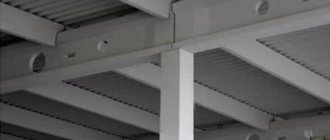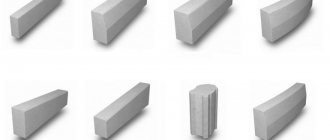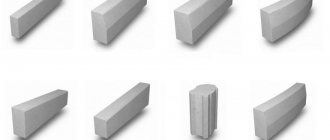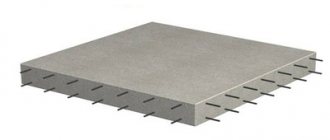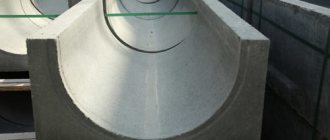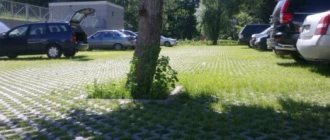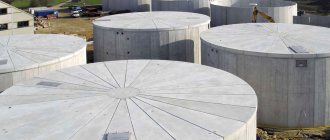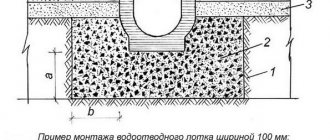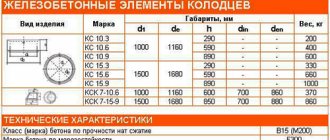Concrete water drains are used to organize surface drainage and remove excess moisture from the site resulting from precipitation and melt water flows. Structures of this type are actively used in residential/industrial complexes, on highways and other facilities.
Reinforced concrete trays and water drains are the most effective option for arranging drainage structures. A drainage system is created from the trays, which can act as both a functional element and even a decoration of the site (when made of colored concrete, original design, combined with paving slabs, architectural objects).
The main advantages of using reinforced concrete trays and blocks
Drainage gutters are used everywhere today, as they are suitable for creating and operating a system of any complexity, volume, at a particular facility. Using concrete products, the entire structure can be easily and quickly assembled.
The main advantages of creating a system for draining water from concrete drains:
- Simple and quick installation
- Effective removal of waste, groundwater, rain, and melt water from the site in accordance with established standards
- Aesthetics and no need for special care
- Mechanical strength, reliability and durability of the system
- Resistance to temperature changes and various external negative influences
Placement examples
Concrete drainage gutters are used in a wide variety of situations and conditions - they are installed along access roads, in pedestrian areas, at various types of sports facilities, in places of active traffic, often in parking lots. Such systems are also relevant for private and industrial facilities, where it is necessary to ensure water drainage and thereby increase comfort and quality of operation.
The trays must be placed in such a way as not to interfere with the passage of people and vehicles, maintain their characteristics and freely withstand the considerable weight of cars. Usually, for these purposes, strong and reliable gutters are created from reinforced concrete with a rectangular or square cross-section.
Where there is a limitation in depth (garages, roofs, balconies, etc.), drainage concrete trays made in the format of small small sections are used.
Modern manufacturers offer a fairly large selection of different options for the execution of concrete products of this type, so in the design process the main stage is the correct execution of calculations, and finding elements for forming a system of the desired configuration is not difficult.
Prices, features and specifications
A concrete drainage tray is the basic element of a drainage system. The price of the product can vary within quite noticeable limits and depends on the material of manufacture, size and weight, design features: the tray can be made of concrete or a polymer-sand mixture, gray or with the addition of pigments, with or without reinforcement, equipped with a grid (copper, stainless steel or ordinary steel, cast iron).
On average, prices start from 50-100 rubles for small sidewalk concrete trays and reach impressive amounts for products with polymers, gratings, special shapes, colors, etc.
Where to buy
You can buy concrete gutters for drainage directly from the factory or from companies that cooperate with manufacturers. When choosing, you should contact only trusted companies that have a certificate for product quality, all relevant licenses and permits.
The quality of the product is guaranteed by the following conditions: the use of modern high-precision equipment and safe high-quality materials in production, full compliance of the process with established technology, compliance of finished products with GOSTs and all parameters specified therein, which is determined during multi-stage checks (usually at each stage of production).
Sealing Recommendations
To seal the joints, standartpark one-component polyurethane sealant is used. This sealant is universal and is suitable for drainage trays of all materials.
Where ducts are subject to horizontal forces, such as in concrete areas or concrete areas with additional reinforcement, an effective expansion joint must be provided on both sides of the duct line. The forces acting on the expansion joint must not act on the side walls of the channel.
In order to leave a groove for pouring sealant between the cladding and the concreted area, it is necessary to lay plates of plywood or plastic 5-10 mm thick. These plates are laid while the cement mixture remains mobile and removed after setting begins. It is recommended to carry out work at a temperature not lower than 0 °C. Preparatory work
The sealant is poured into the connecting seams immediately at the time of installation of the trays.
You can buy concrete trays from Standardpark and choose the right grates for them on the website or at sales offices, including ordering a design solution for arranging a surface drainage system. If you need advice or find out additional information, please contact us!
Types of trays used
A concrete tray can be different in shape, configuration, appearance, strength, purpose and other parameters. According to the method of installation, trays can be telescopic (elements are installed one inside the other, draining water from embankments, bridges along a slope) and edge trays (usually installed in a cascade or along roads at a single level).
Types of trays by section shape:
- Trapezoidal - assume telescopic installation, made in a trapezoid format.
- U-shaped - designed to drain minor volumes of water, an ideal choice for a private household.
- U-shaped - have the largest cross-sectional area and are used for installing systems with heavy loads.
Based on the material used, gutters can be made of concrete, with the addition of polymers and a sand mixture.
Concrete
The strongest and most durable products can withstand external loads ranging from 60 to 90 tons. They are made from cement and fillers, can be reinforced, come in different colors (if pigment is added to the concrete), and come in a huge variety of shapes and sizes.
Concrete gutters are often used to install systems for draining stormwater and melt water into sewers.
Polymer concrete
They simultaneously have the properties of plastic and concrete waste. They are made from granite chips and quartz sand with special epoxy and polyester resins. Cement is replaced by polymer compounds, which makes the structure resistant to various types of chemical elements.
Due to the inclusion of plastic, the product is light in weight, which makes installation and creation of the entire system easier. Often such drains are used in private housing construction, equipped with gratings.
Polymer sand
Such gutters are the most modern and technologically advanced solution. The effluents have high plasticity rates and an extremely long service life. They are made from polymer chips with special sand of a very fine fraction.
In terms of strength, drains are in no way inferior to concrete products, but have minimal weight, which significantly speeds up and simplifies installation.
Connections to other system elements
Drainage gutters in their design provide connections with similar channels, sand traps, rainwater wells or sewer pipes. Joints of adjacent elements must be sealed. The locations and parameters of the holes can be viewed in the drawings, which are located on the detailed page of the specific type of concrete trays.
Additional components include special adapters and end caps. Their use will simplify the installation process, make the system complete and airtight, and comply with the developed design solution.
Dimensions and volumes
All data about the sizes and volumes of products can be found in the labeling. The first letters and numbers next to it are the size, and the next number indicates the vertical load, then the length of the tray is indicated. Manufacturers adhere to uniform standards in labeling.
In addition to the length, height and width of the product, the hydraulic cross-section is indicated - all this is important for calculating the water throughput of the entire drainage system. To determine the required dimensions, professionals make a hydraulic calculation using a special formula. The weight of the trays directly depends on the size and load class; it is taken into account only during the transportation and installation processes.
Dimensions and volumes of drains for water drainage:
- The hydraulic section of the tray (DN) is the width of the internal section, expressed in numbers (millimeters). So, DN100 means that the internal width of the gutter is 100 millimeters. There are DN100, 150, 200, DN300, 400, 500.
- B - the outer width of the tray, usually varies between 140-603 millimeters, depends on the thickness of the drain walls and the hydraulic section.
- L – length, usually equal to a meter (1000 or 1050 millimeters), but there are also standard sizes: 500, 1100, 1200 millimeters, as well as 2060, 2360, 2400 and 2950 mm.
- H – height can be in the range of 60-700 millimeters. Sometimes the documents also indicate the internal height of the drain (hydraulic), which depends on the thickness of the walls. If the height of the trays is small, they are also called shallow-sitting.
Water waste volume:
- L 1-7 – 0.07 m3
- L 2-7 – 0.07 m3
- L 3-8 – 0.14 m3
- L 300 – 0.3 m3
When choosing, you need to focus on calculations and operating conditions, installation location, volumes of water discharged - for example, a road drain for a highway will be much larger than a drain for a local area.
Self-installation
Installing a drainage system with your own hands is not as difficult as it might seem. The most crucial moment is the calculation of all values and the selection of products with the required parameters, and their installation is relatively easy.
The preparatory stage looks like this: creating a project and diagram, taking measurements, calculations, selecting trays taking into account the design load and soil properties, determining the laying depth and ultimate capacity.
Preparing the trench
Often concrete channels are laid under drains in the form of a concrete layer at the bottom of the pit and side supports. The channels are made with a slope to ensure self-drainage of water. In this case, the length of the trench should be equal to the length of the entire system, the width should be 20 centimeters greater than the width of the drain. The depth is made equal to the height of the gutter with the grate plus a concrete layer and a 5 millimeter distance to the surface.
The location of the trenches can be marked with cords. After the trenches are ready, they are covered with sand in a layer of 10-15 centimeters, then thoroughly compacted. Concrete mortar is poured on top of the sand in a layer 10 centimeters thick. Only after this can the trays be installed.
If the system is installed on heaving soils, it is advisable to strengthen the trench and the entire structure with steel wire or rods.
Laying trays
The trays are laid using a certain technology. Despite the fact that the process itself is quite simple, you should not ignore any of the stages.
Sequence of laying trays:
- Laying out drains along the channels, choosing the highest point of the trench.
- Installing the gutter on still fresh concrete so that the elements do not move under load. It is imperative to maintain a certain level of inclination during installation.
- When 2 trays are installed, you need to ensure that the joints are sealed with a strand of any soft polymer, then fill them with concrete mortar.
- A tray is installed in the center of the trench, and to make it easier to remove the remaining concrete, it is covered with a polyethylene film when finished.
- The concrete mixture is poured into the distance between the trays and the sides of the trench.
- All corners are also treated with sealant.
- If you plan to lay asphalt on top of the drainage system, it is advisable to cover the trenches with fiberboards.
- After the trays are installed, all side spaces are carefully filled with a mixture of sand and gravel and compacted thoroughly (you can also fill it with concrete instead of backfill).
- After everything is compacted (if concrete was poured, it should harden), the upper parts of the drains are covered with grates. If it is necessary to make corner joints, the gratings are carefully sawed with a saw with a diamond blade.
Concrete water drains are high-quality and durable products, thanks to which you can quickly and easily install an effective water drainage system, guaranteeing the comfort and safety of operation of the territory and the objects located on it.
